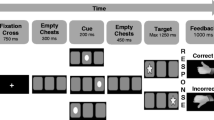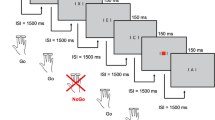Abstract
Theoretical accounts of attention-deficit/hyperactivity disorder (ADHD) posit a prominent role for problems in response inhibition (Nigg 2006). A key avenue for impulsivity in children with ADHD is inappropriate language expression. In this study, we sought to determine whether poor inhibitory control affects language production in adolescents and adults with ADHD. One hundred and ninety-five participants (13–35 years old; 65% male) were presented with two pictures and a verb, and their task was to form a sentence. If deficits in response inhibition affect language production, then participants with ADHD should be more likely than non-ADHD controls to begin speaking before having formulated a plan that will allow a grammatical continuation. The results showed that the ADHD-combined subtype, in particular, was more likely to produce an ungrammatical sequence. Effects were not moderated by age or gender. These data suggest that response suppression deficits in ADHD adversely affect the basic processes of sentence formation.



Similar content being viewed by others
References
Achenbach, T. (1991). Manual for the young adult self-report and young adult behavior checklist. Burlington: University of Vermont.
American Psychiatric Association. (1994). Diagnostic and statistical manual of mental disorders (4th ed.). Washington, DC: American Psychiatric Association.
American Psychiatric Association. (2000). Diagnostic and statistical manual of mental disorders (4th ed.). Washington, DC: American Psychiatric Association. text rev.
Barkley, R. A. (1997). Behavioral inhibition, sustained attention, and executive functions: constructing a unifying theory of ADHD. Psychological Bulletin, 1, 65–94. doi:10.1037/0033-2909.121.1.65.
Barkley, R. A., & Murphy, K. R. (2006). Attention deficit hyperactivity disorder: A clinical workbook-3rd Edition. New York: Guilford.
Barkley, R. A., Cunningham, C. E., & Karlsson, J. (1983). The speech of hyperactive children and their mothers: comparison with normal children and stimulant drug effects. Journal of Learning Disabilities, 16, 105–110. doi:10.1177/002221948301600209.
Barkley, R. A., Fischer, M., Smallish, L., & Fletcher, K. (2002). The persistence of attention-deficit/hyperactivity disorder into young adulthood as a function of reporting source and definition of disorder. Journal of Abnormal Psychology, 111, 279–289. doi:10.1037/0021-843X.111.2.279.
Beitchman, J. H., Hood, J., & Inglis, A. (1990). Psychiatric risk in children with speech and language disorders. Journal of Abnormal Child Psychology, 18, 283–296. doi:10.1007/BF00916566.
Berry, C. A., Shaywitz, S. E., & Shaywitz, B. A. (1985). Girls with attention deficit disorder: a silent minority? A report on behavior and cognitive characteristics. Pediatrics, 76, 801–809.
Biederman, J., Faraone, S. V., Keenan, K., Knee, D., & Tsuang, M. T. (1990). Family-genetic and psychosocial risk factors in DSM–III attention deficit disorder. Journal of the American Academy of Child and Adolescent Psychiatry, 29, 526–533.
Blaskey, L. G. (2004). Inhibitory language deficits in attention-deficit/hyperactivity disorder and reading disorder: a candidate shared deficit. Unpublished doctoral dissertation. Michigan State University.
Bock, J. K. (1987). An effect of the accessibility of word forms on sentence structures. Journal of Memory and Language, 26, 119–137. doi:10.1016/0749-596X(87)90120-3.
Bock, J. K., & Cutting, J. C. (1992). Regulating mental energy: performance units in language production. Journal of Memory and Language, 31, 99–127. doi:10.1016/0749-596X(92)90007-K.
Bock, J. K., & Warren, R. K. (1985). Conceptual accessibility and syntactic structure in sentence formulation. Cognition, 21, 47–67. doi:10.1016/0010-0277(85)90023-X.
Brown, T. E. (1996). Brown attention-deficit disorder scales. San Antonio: Psychological Corporation.
Carr, L. A., Nigg, J. T., & Henderson, J. M. (2006). Attentional versus motor inhibition in adults with attention deficit hyperactivity disorder. Neuropsychology, 20, 430–441. doi:10.1037/0894-4105.20.4.430.
Christianson, K., & Ferreira, F. (2005). Conceptual accessibility and sentence production in a free word order language (Odawa). Cognition, 98, 105–135. doi:10.1016/j.cognition.2004.10.006.
Cohen, N. J., Davine, M., Horodezky, N., Lipsett, L., & Isaacson, L. (1992). Unsuspected language impairment in psychiatrically disturbed children: prevalence, language, and behavioral characteristics. Journal of the American Academy of Child and Adolescent Psychiatry, 32, 595–603.
Conners, C. K., Erhardt, D., & Sparrow, E. (1999). Adult ADHD Rating Scales: Technical manual. Toronto, Ontario, Canada: Multi-Health Systems.
Denckla, M. B. (1996). Biological correlates of learning and attention: what is relevant to learning disability and attention-deficit hyperactivity disorder? Developmental and Behavioral Pediatrics, 17, 114–119. doi:10.1097/00004703-199604000-00011.
Dick, F., & Elman, J. L. (2001). The frequency of major sentence types over discourse levels: a corpus analysis. Center for Research in Language Newsletter, 13, 3–18.
Faraone, S. V., Biederman, J., Spencer, T., Wilens, T., Seidman, L. J., Mick, E., et al. (2000). Attention-deficit/hyperactivity disorder in adults: an overview. Biological Psychiatry, 48, 9–20. doi:10.1016/S0006-3223(00)00889-1.
Ferreira, F. (1994). Choice of passive voice is affected by verb type and animacy. Journal of Memory and Language, 33, 715–736. doi:10.1006/jmla.1994.1034.
Ferreira, F., & Engelhardt, P. E. (2006). Syntax and Production. In M. Traxler & M. A. Gernsbacher (Eds.), Handbook of psycholinguistics (pp. 61–91). Oxford: Elsevier Inc.
Flory, K., Milich, R., Lorch, E. P., Hayden, A. N., Strange, C., & Welsch, R. (2006). Online story comprehension among children with ADHD: which core deficits are involved? Journal of Abnormal Child Psychology, 34, 853–865. doi:10.1007/s10802-006-9070-7.
Friedman, N. P., Haberstick, B. C., Willcutt, E. G., Miyake, A., Young, S. E., Corley, R. P., et al. (2007). Greater attention problems during childhood predict poorer executive functioning in late adolescents. Psychological Science, 18, 893–900. doi:10.1111/j.1467-9280.2007.01997.x.
Giedd, J. N., Blumenthal, J., Jefferies, N. O., Castellanos, F. X., Lui, H., Zijdenbos, A., et al. (1999). Brain development during childhood and adolescents: a longitudinal MRI study. Nature Neuroscience, 2, 861–863. doi:10.1038/13158.
Hamlett, K. W., Pellegrini, D. S., & Connors, C. K. (1987). An investigation of executive processes in the problem solving of attention deficit disordered-hyperactive children. Journal of Pediatric Psychology, 12, 227–240. doi:10.1093/jpepsy/12.2.227.
Hart, E. L., Lahey, B. B., Loeber, R., Applegate, B., & Frick, P. J. (1995). Developmental change in attention-deficit hyperactivity disorder in boys: a four-year longitudinal study. Journal of Abnormal Child Psychology, 23, 729–749. doi:10.1007/BF01447474.
Javorsky, J. (1996). An examination of youth with attention-deficit/hyperactivity disorders and language learning disabilities: a clinical study. Journal of Learning Disabilities, 29, 247–258. doi:10.1177/002221949602900303.
Johnson, J. R., Miller, J. F., Curtiss, S., & Tallal, P. (1993). Conversations with children who are language impaired: asking questions. Journal of Speech and Hearing Research, 36, 973–978.
Kessler, R. C., Adler, L., Barkley, R., Biederman, J., Conners, C. K., & Demler, O. (2006). The prevalence and correlates of adult ADHD in the United States: results from the National Comorbidity Survey Replication. The American Journal of Psychiatry, 163, 716–723. doi:10.1176/appi.ajp. 163.4.716.
Lahey, B. B., Pelham, W. E., Loney, J., Lee, S. S., & Willcutt, E. G. (2005). Instability of the DSM-IV subtypes of ADHD from preschool through elementary school. Archives of General Psychiatry, 62, 896–902. doi:10.1001/archpsyc.62.8.896.
Lorch, E. P., Milich, R., Sanchez, R. P., van den Broek, P., Baer, S., Hooks, K., et al. (2000). Comprehension of televised stories in boys with attention deficit hyperactivity disorder and non-referred boys. Journal of Abnormal Psychology, 109, 321–330. doi:10.1037/0021-843X.109.2.321.
Meyer, A. S., Wheeldon, L. R., & Krott, A. (2007). Automaticity and control in language processing. New York: Psychology Press.
Milich, R., Balentine, A., & Lynam, D. R. (2001). ADHD combined type and inattentive type are distinct and unrelated disorders. Clinical Psychology: Science and Practice, 8, 463–488. doi:10.1093/clipsy/8.4.463.
Murphy, K., & Barkley, R. A. (1996). Attention deficit hyperactivity disorder adults: comorbidities and adaptive impairments. Comprehensive Psychiatry, 37, 393–401. doi:10.1016/S0010-440X(96)90022-X.
Nigg, J. T. (2001). Is ADHD a disinhibtion disorder? Psychological Bulletin, 127, 571–598. doi:10.1037/0033-2909.127.5.571.
Nigg, J. T. (2006). What causes ADHD? Understanding what goes wrong and why. New York: Guilford.
Puig-Antich, J., & Ryan, N. (1986). The schedule for affective disorders and Schizophrenia for school-age children (Kiddie-SADS)—1986. Pittsburg: Western Psychiatric Institute and Clinic.
Purvis, K., & Tannock, R. (1997). Language abilities in children with attention deficit hyperactivity disorder, reading disabilities, and normal controls. Journal of Abnormal Child Psychology, 25, 133–144. doi:10.1023/A:1025731529006.
Rashid, F. L., Morris, M. K., & Morris, R. (2001). Naming and verbal memory skills in adults with attention deficit hyperactivity disorder and reading disability. Journal of Clinical Psychology, 57, 829–838. doi:10.1002/jclp. 1052.
Redmond, S. M. (2004). Conversational profiles of children with ADHD, SLI, and typical development. Clinical Linguistics & Phonetics, 18, 107–125. doi:10.1080/02699200310001611612.
Schachar, R., Tannock, R., Marriott, M., & Logan, G. D. (1995). Deficient inhibitory control and attention deficit hyperactivity disorder. Journal of Abnormal Child Psychology, 23, 411–437. doi:10.1007/BF01447206.
Scott, C. M., & Windsor, J. (2000). General language performance measures in spoken and written narrative and expository discourse of school-aged children with language learning disabilities. Journal of Speech, Language, and Hearing Research: JSLHR, 43, 324–339.
Tannock, R., & Schachar, R. (1996). Executive dysfunction as an underlying mechanism of behavior and language problems in attention deficit hyperactivity disorder. In J. Beitchman, N. Cohen, M. M. Konstantearas & R. Tannock (Eds.), Language, learning, and behavior disorders (pp. 128–155). Cambridge: University Press.
Tannock, R., Purvis, K., & Schachar, R. (1993). Narrative abilities in children with attention deficit hyperactivity disorder and normal peers. Journal of Abnormal Child Psychology, 21, 103–117. doi:10.1007/BF00910492.
Tirosh, E., & Cohen, A. (1998). Language deficit with attention-deficit disorder: a prevalent comorbidity. Journal of Child Neurology, 13, 493–497. doi:10.1177/088307389801301005.
Wechsler, D. (1997a). Wecshler adult intelligence scale (3rd ed.). San Antonio: The Psychological Corporation.
Wechsler, D. (1997b). Wecshler intelligence scale for children (4th ed.). San Antonio: The Psychological Corporation.
Wechsler, D. (2001). Wecshler Individual Achievement Test (2nd ed.) (WIAT – II). San Antonio: The Psychological Corporation.
Weiss, M., Hechtman, L. T., & Weiss, G. (1999). ADHD in adulthood: A guide to current theory, diagnosis, and treatment. Baltimore: Johns Hopkins University Press.
Wender, P. H., Wolf, L. E., & Wasserstein, J. (2001). Adults with ADHD: An overview. In J. Wasserstein, L. E. Wolf & F. F. LeFever (Eds.), Annals of the New York Academy of Sciences: Vol. 931. Adult attention deficit disorder: Brain mechanisms and life outcomes (pp. 1–16). New York: New York Ac. of Sciences.
Wilkinson, G. S. (1993). The wide range achievement test administration manual. Wilmington: Wide Range.
Willcutt, E. G., & Pennington, B. F. (2000). Comorbidity of reading disability and attention-deficit/hyperactivity disorder: differences by gender and subtype. Journal of Learning Disabilities, 33, 179–191. doi:10.1177/002221940003300206.
Willcutt, E. G., Pennington, B. F., & DeFries, J. C. (2000). Etiology of inattention and hyperactivity/impulsivity in a community sample of twins with learning difficulties. Journal of Abnormal Child Psychology, 28, 149–159. doi:10.1023/A:1005170730653.
Willcutt, E. G., Pennington, B. F., Boada, R., Ogline, J. S., Tunick, R. A., Chabildas, N. A., et al. (2001). A comparison of the cognitive deficits in reading disability and attention-deficit/hyperactivity disorder. Journal of Abnormal Child Psychology, 110, 157–172.
Zentall, S. S. (1988). Production deficiencies in elicited language but not in the spontaneous verbalizations of hyperactive children. Journal of Abnormal Child Psychology, 16, 657–673. doi:10.1007/BF00913476.
Author information
Authors and Affiliations
Corresponding author
Additional information
Study protocols were approved by Michigan State University’s Human Research Protection Program, and conformed to APA ethical standards. This research was supported by National Institutes of Health, National Institute of Mental Health Grant R01-MH63146 to Joel T. Nigg and Fernanda Ferreira.
Rights and permissions
About this article
Cite this article
Engelhardt, P.E., Ferreira, F. & Nigg, J.T. Priming Sentence Production in Adolescents and Adults with Attention-Deficit/Hyper-Activity Disorder. J Abnorm Child Psychol 37, 995–1006 (2009). https://doi.org/10.1007/s10802-009-9323-3
Published:
Issue Date:
DOI: https://doi.org/10.1007/s10802-009-9323-3




